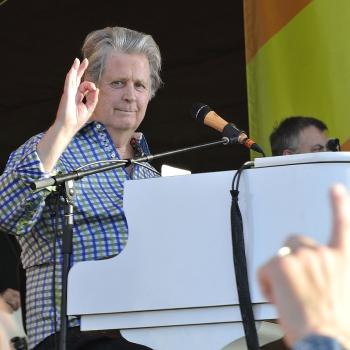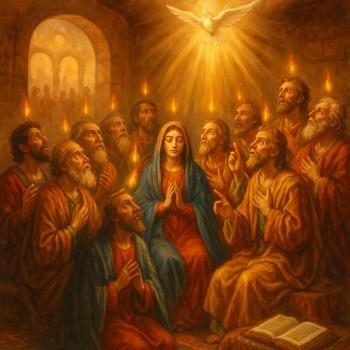 Last night, I spent nearly three hours enthralled by the movie adaptation of David Mitchell’s Cloud Atlas. As a process theologian, whose work has been influenced by the philosophies of Alfred North Whitehead and Charles Hartshorne, the film’s portrayal of quantum entanglement, what Einstein described as “spooky action at a distance” reflects my own vision of life. Whether or not this film is a testimony to the past, present, and future incarnations of its protagonists, it is an invitation to consider the intricate web of relationships from which each life emerges. The philosopher Whitehead asserted that the whole universe conspires to create each moment of experience. We are not alone, nor are we self-created; in the words of President Obama, none of us built our companies or achieved our success on our own. Each moment joins past, present, and future. The process of creative transformation emerges from the past, gathering the influences of its immediate and cosmic environments; shapes that past into an aesthetic act of creation; and leans toward the future in its role as a shaper of the future. (For more on process theology, see Bruce Epperly, Process Theology: A Guide for the Perplexed and Emerging Process: Adventurous Theology for a Missional Church.
Last night, I spent nearly three hours enthralled by the movie adaptation of David Mitchell’s Cloud Atlas. As a process theologian, whose work has been influenced by the philosophies of Alfred North Whitehead and Charles Hartshorne, the film’s portrayal of quantum entanglement, what Einstein described as “spooky action at a distance” reflects my own vision of life. Whether or not this film is a testimony to the past, present, and future incarnations of its protagonists, it is an invitation to consider the intricate web of relationships from which each life emerges. The philosopher Whitehead asserted that the whole universe conspires to create each moment of experience. We are not alone, nor are we self-created; in the words of President Obama, none of us built our companies or achieved our success on our own. Each moment joins past, present, and future. The process of creative transformation emerges from the past, gathering the influences of its immediate and cosmic environments; shapes that past into an aesthetic act of creation; and leans toward the future in its role as a shaper of the future. (For more on process theology, see Bruce Epperly, Process Theology: A Guide for the Perplexed and Emerging Process: Adventurous Theology for a Missional Church.
This fall, politicians have argued about issues of creativity and causation, based on their respective philosophies. While politicians often don’t make the best of philosophers, everything they do emerges from their vision of life or their vision of what their supporters believe and will vote for. The Tea Party, for example, is the epitome of out-of-date modern metaphysics in its one-sided image of human self-sufficiency. Its individualistic, low tax, and non-communal political vision is grounded in a sense of separation in which we can do it on our own, without the help of others and in which community altruism is optional rather than mandatory in our relationships. Hence, the outrage some felt at President Obama’s comment, “you didn’t build that.”
In fact, the President’s comment reflects the nature of reality, described by ecology, quantum physics, and social relatedness: You were successful, somebody along the line gave you some help. There was a great teacher somewhere in your life. Somebody helped to create this unbelievable American system that we have that allowed you to thrive. Somebody invested in roads and bridges. If you’ve got a business—you didn’t build that. Somebody else made that happen.
The philosopher-in-chief may not have expressed his beliefs as well as possible, but he’s right, according to the “Cloud Atlas.” The self-made person is the person most to be pitied in quantum physics and biblical theology. The self-made person is all alone in the universe and is constantly worried about issues of scarcity, since he or she has few resources outsider her or himself. Only by opening ourselves to the creative energies of the universe, flowing in and through the universe, do we experience the fullness of life.
The “Cloud Atlas” takes another approach. It joins initiative, freedom, and interdependence. Each protagonist is asked to be a creator, an actor in her or his own life. Each protagonist makes a difference; the impact of her or his actions, localized though they appear to be, radiate across the universe, bringing joy and sorrow to those who succeed them. We are not alone; we create each other and the universe by our choices and values.
The “Cloud Atlas” presents the tension between order and novelty and suggests that uniformity is dependent an inflexible, but brittle, quest for order, when in fact the universe aims at novelty and fluidity. Adventurers are invited to sail forth beyond their comfort zones, inspired by a holy restlessness that challenges corporate disinformation, institutional greed, totalitarianism, and oppression. We live in a lively universe in which, as Whitehead states, the pure conservative – and I would add, the pure individualist – is going against the grain of the universe. Life aims at novelty: survival, then living well, and ultimately living better, and this depends on embracing creativity and relatedness.
Many people will find the “Cloud Atlas” to complex and subtle, but life itself is subtle and complicated. Spooky action at a distance joins us all in a web such that where I begin and end in the relatedness of life will always remain a mystery. We are created creators, whose actions help shape the communities around us and may determine the future of this good Earth.













